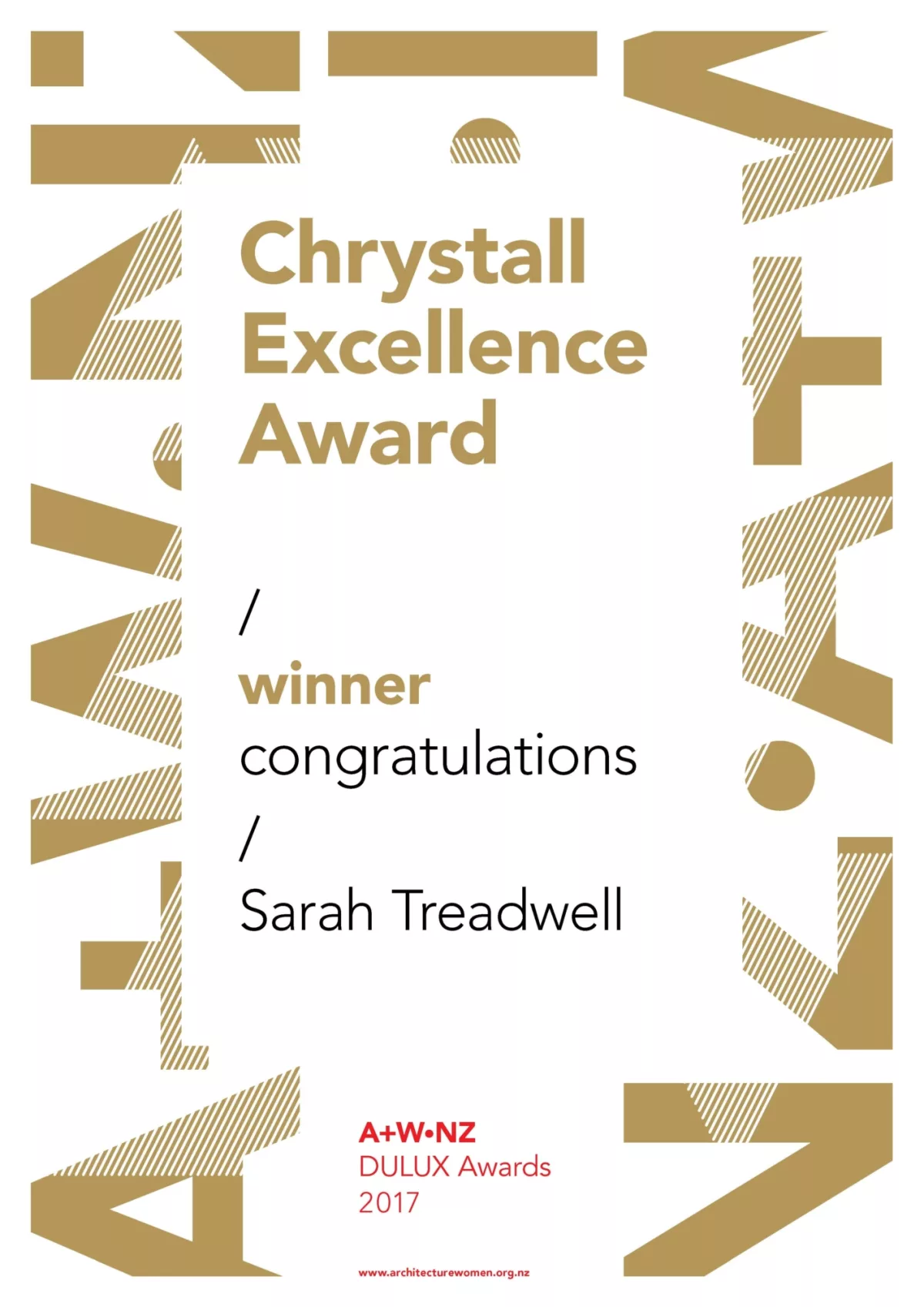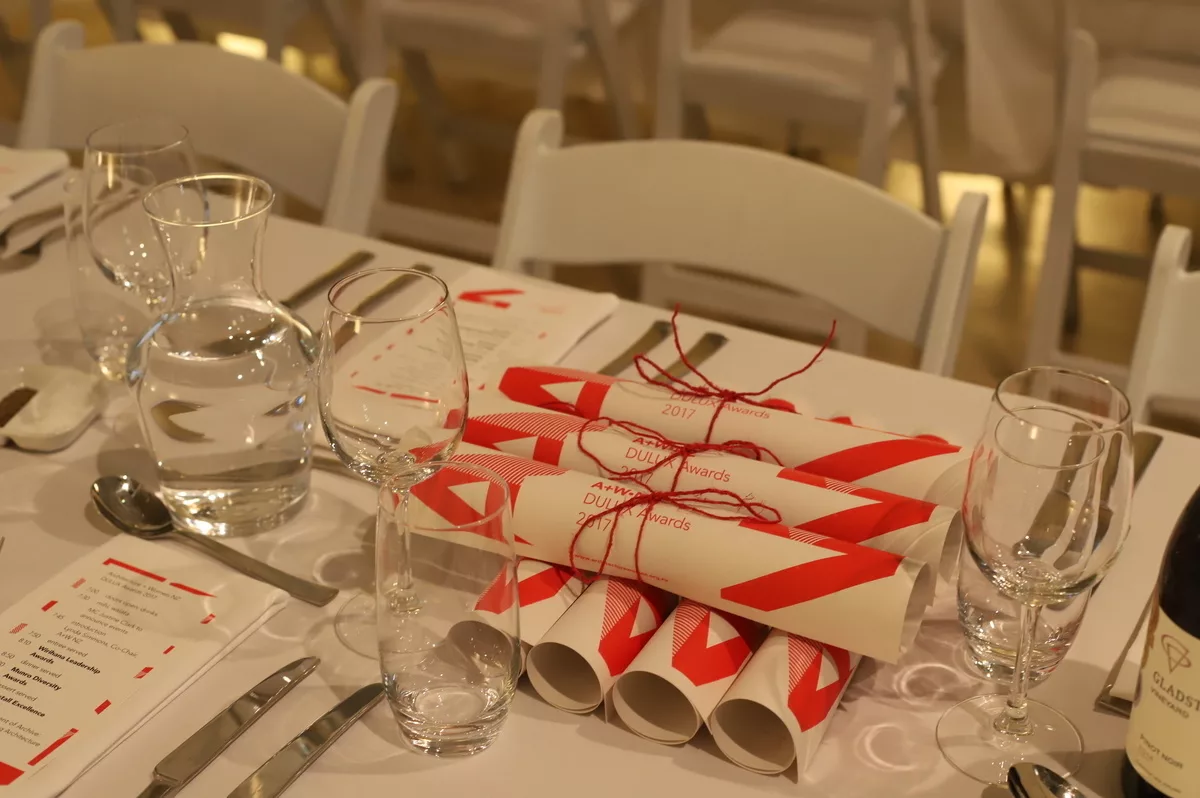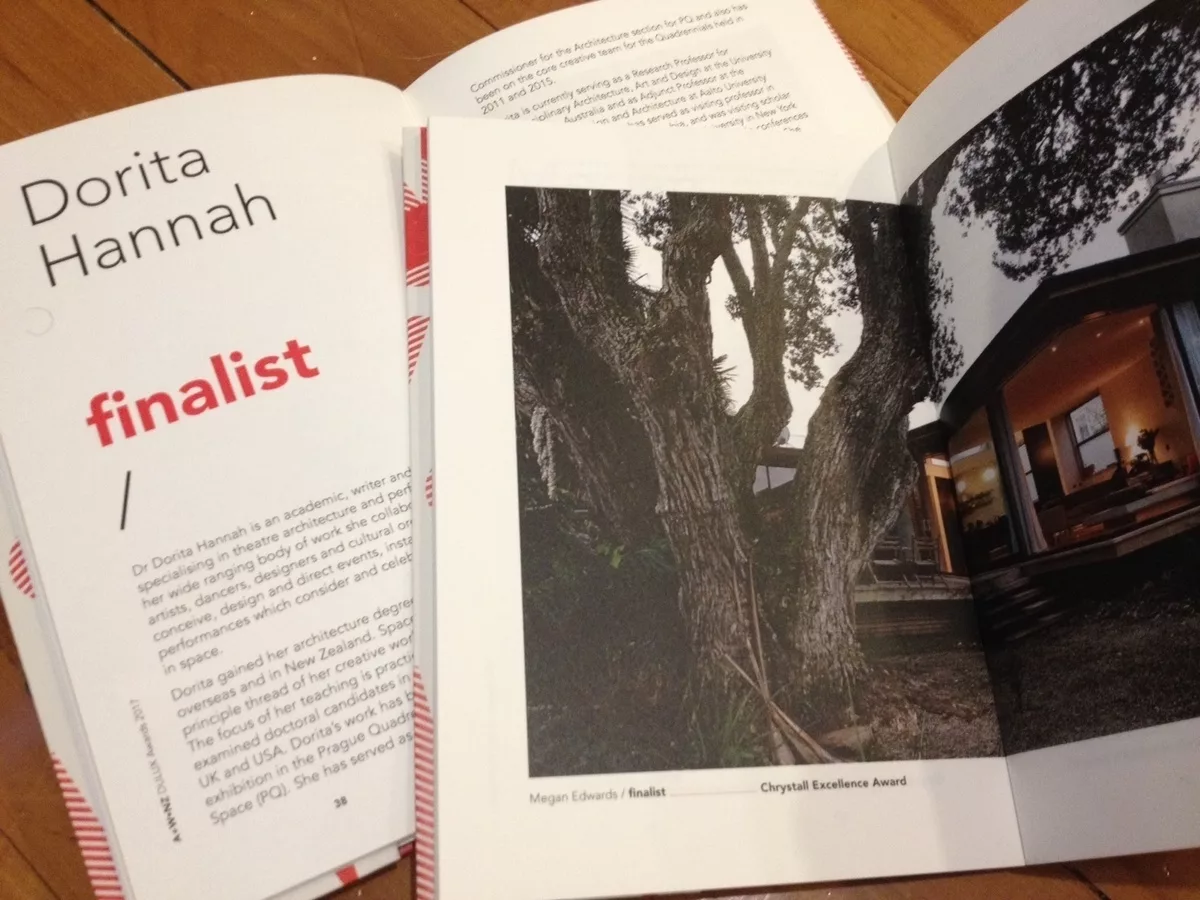Parlour Article: Filling the Gaps by Lynda Simmons
21 Apr 2023We are always very proud to have the support of Australia's Parlour, world leaders in issues of equity, gender and architecture. On 5 November 2018, Parlour published an article on the A+W NZ Dulux Awards, written by Lynda Simmons. The article was written at the request of Parlour's editor Justine Clark, who has recognised the impact that the awards programme has had on the profession in New Zealand and surrounding communities. Justine was the MC at the A+W NZ Dulux Awards 2017, and along with Gill Matthewson, was the recipient of the Munro Diversity Award in the inaugural A+W NZ Awards 2014.
Filling The Gaps 5 November 2018
The article is re-printed below;

The architectural and design communities are smothered in awards programs – some would argue that there are too many awards events each year by too many organisations, possibly devaluing those awards programs with history, mana and proven high quality.
In 2014, A+W•NZ added to this already saturated field with the establishment of a new awards program, a triennial event with three award categories. Adding to the existing ‘over-supply’ was due to a general awareness that despite the abundance, there are clearly identified gaps that existing awards programs do not fill. 1 The lack of diversity on stage at any architectural awards event is common, proving that while the existing (mostly excellent) systems serve many well, whole groups of people working in architecture are still unseen to the profession.
With the A+W•NZ Dulux Awards, we sought to create a supplementary system that shifts the attitude, the method and the outcome – of what is measured and who is rewarded. 2
With the A+W•NZ Dulux Awards, we sought to create a supplementary system that shifts the attitude, the method and the outcome – of what is measured and who is rewarded.
There are two core aims of the A+W•NZ Inc non-profit organisation – raising the visibility of women trained in architecture and associated with New Zealand, and enabling inclusive, equitable work environments – and the A+W•NZ Dulux Awards program works with both. By working from the already strong platform of gender, the intention is to increase true and broad diversity in the architectural profession.
Three award categories:
Wirihana Leadership Award
It has been recognised that by the second decade beyond graduation, the career progression and registration ratio between male and female graduates is skewed.3 This period is significant for all architectural careers, and it seems that just as mentoring relationships are defined and future leaders noted, females become less visible. This award aims to maintain focus on female leaders in this important stage of their architectural lives.
The category is open to all members on the A+W•NZ Database who are in their second decade after the date of their graduation. Note: the only exclusions for all three categories relate to A+W NZ Core and Awards Team members.
The naming of this award, after Moana Wirihana (Te Kawerau-a-Maki), calls attention to a rich Maori architectural lineage of women in architecture in New Zealand. Like others such as Te Puea Herangi and Dame Whina Cooper, Moana Wirihana’s strong leadership overseeing the design and construction of wharenui has had a large impact on the enduring strong state of toi waihanga, whakairo and tukutuku, and their influence in contemporary society and architecture.
The naming of this award, after Moana Wirihana (Te Kawerau-a-Maki), calls attention to a rich Maori architectural lineage of women in architecture in New Zealand.


Munro Diversity Award
We believe that the architectural profession is made stronger through the consistent support of those who encourage and celebrate diversity, and hope this award category makes this invaluable work more visible. The Munro Diversity Award is open to all genders, and looks specifically for evidence of continued support strategies for diversity in the workplace, including but not necessarily restricted to gender. The aim is to recognise the invisible work that goes into supporting the many and varied sectors of the architectural community. It is intended that over time, the focus of this award moves from gender (when hopefully issues of gender equity are less pressing) to other areas of diversity more relevant to the era of each award round.
The category is open to all whose careers are in or around the field of architecture. Typically professional awards omit academia and other areas of our community, and the open nature of this award category bring them together.
The naming of this award category acknowledges the social systems in place in early New Zealand architecture, recognising affluence as a requirement for an architectural education, and stereotypes restricting full access to the title of Architect for some people, especially women. Munro had worked in Christchurch for almost 30 years, in partnership with husband Bob and in the offices of Cecil Wood, before applying to the NZIA for registration in 1960. Her sudden requirement for registration was due to the death of her husband, so that she could continue running their office, which she did until her retirement in 1975.
The naming of this award category, after Margaret Munro, acknowledges the social systems in place in early New Zealand architecture, recognising affluence as a requirement for an architectural education, and stereotypes restricting full access to the title of Architect for some people.


Chrystall Excellence Award
This award is a celebration of those women who have led expanded and full careers in architecture over several decades. A major focus of this career award is recognition of excellence in a body of work, leadership, and contribution to the community through mentorship. The award takes into account the broad range of areas to which women often contribute, within and around the architectural profession. The intention of this award is to make visible the talent of women at the top of the architectural field, possibly influencing generations of students as well as the future consideration for the NZIA Gold Medal – deemed the highest accolade of the profession in New Zealand and one which has never been awarded to a woman.
The category is open to all members of the A+W•NZ Database, plus pre-1972 graduating women, who have had a full career in architecture of at least three decades.
Lillian Chrystall is a role model to so many, being the first female to win an NZIA National Award in 1967, one of the earliest to set up her own practice, the first female design tutor at The University of Auckland as part of Vernon Brown’s studio, and a Fellow of the NZIA. While a reluctant star, Lillian has undoubtedly generated a significant body of work, influenced many and contributed to Auckland’s urban environment in both a pragmatic and uncontroversial manner. With her retirement in 2012 following a 64-year career, Lillian is one of New Zealand’s most enduring and talented practitioners, and we are proud that she has lent her name to our excellence award.
With her retirement in 2012 following a 64-year career, Lillian is one of New Zealand’s most enduring and talented practitioners, and we are proud that she has lent her name to our excellence award.


It is noted by many that there is no award category for students and graduates of architecture, and this was a deliberate decision made at the time of establishing this award program. The reason for this decision is based on observation and research showing that disparities between genders for career progression do not appear until after approximately 5–7 years post-graduation. 4
We also believe that the student and graduate group is already well-served by many New Zealand award programs – such as the NZIA Student Award, AAA Visionary Award and DINZ Best Design Awards – and that there are no longer significant barriers for females at the universities, which now enjoy a gender balance nationally.5 This current situation is thanks to the hard work of many who have been before, especially those involved with the Women’s Institute of Architecture in the late 1970s,6, the nationwide ‘Constructive Agenda’ exhibition of 1993 7, and of course the legacy of Dr Sarah Treadwell. We all owe them so much.



Small shifts have a big impact
A+W•NZ believes that constant small actions make a large contribution to change, and tend to act incrementally in all areas of our advocacy. With a view to the aims of filling identified gaps left by other awards programs available (eg. low entry rate for females, high entry cost and time commitments, unbalanced juries 8 etc), the A+W•NZ Dulux Awards were designed to have as few barriers to entry as possible, to strengthen networks through collegial generosity, and to attempt to honour work that can often go unseen. The following series of small shifts were identified and made:
1. Entry to the A+W•NZ Dulux Awards is free
To ensure the awards remain inclusive, they are structured to minimise the cost and time commitments that are so often a barrier to award entries. No entry fee is required, and no formatting time or printing costs apply.
2. Entry to the A+W•NZ Dulux Awards is by nomination
The awards are by nomination, with the aim of fostering a generous sense of collegiality among the architectural community. The act of nomination is an important aspect in this process, and the generosity of the nominator forms part of the recognition – making each nomination a joint submission rather than an individual one. (Note that the nominator remains anonymous in the public realm, although they are known to the Jury.)
3. Entry to the A+W•NZ Dulux Awards is simple
To reduce the time commitment for a single participant in the awards entry process, the request for information is spread across three parties:
i. The Nominator: Completes the entry form on behalf of their nominee and submits to A+W•NZ.
ii. The Nominee: Submits their current CV and ten images (max)
iii. The A+W•NZ Dulux Awards Team: Compiles a full file on each nominee
based on the information and images provided, a search of the A+W•NZ
Archives and a Google search. (A+W•NZ are able to provide links to
online material and company websites (already in the public domain) and
in the A+W•NZ archives to supplement the file on each entrant. Note that
no further research is permissible by the A+W•NZ Awards Team at this
stage to avoid bias.)
4. Only three categories
There are only three award categories, aiding each named award category to become familiar and memorable. The key themes behind each award category are Leadership, Diversity and Excellence, with aims and criteria for each as discussed previously. One of the three categories is not gender-restricted, ensuring the whole architectural community is involved in the awards program.
5. All fifteen finalists celebrated at A+W•NZ Dulux Awards Dinner
Despite having only three clear categories, the structure of the awards evening itself ensures that fifteen finalists are celebrated fully and in depth. The A+W•NZ Dulux Awards Dinner event is held at one of the main cities in New Zealand. The location of each A+W NZ Dulux Award round is decided by the current A+W NZ Core Team and always differs from the previous awards location, with an aim of broad national coverage and representation.
Within each category, the A+W•NZ Dulux Awards Jury is asked to select five finalists, and from those five finalists, the Jury chooses one winner. The Jury is selected by the current A+W•NZ Core Team and is always made up of four members: overseas academic and/or practitioner, ‘senior’ academic and/or practitioner NZ, ‘mid-career’ (minimum) academic and/or practitioner NZ, ‘emerging’ practitioner NZ. Each award round sees five people or groups for each category celebrated and documented in the awards publication.
The purpose of the event dinner and publication is to recognise the breadth of talent, rather than only highlight the winners in each category. Feedback from this approach has confirmed that the collegial and generous atmosphere has been felt by many.
6. Awards celebrate a ‘body of work’, not single objects
Often authorship of architecture can be complex to determine, and award programs that are based on recognition of a single building usually reinforce the flagship practice name.
The A+W•NZ Dulux Awards instead reward a ‘body of work’, an approach never taken by a full awards program in New Zealand before. 9 Judging is always based on outstanding architectural design talent, and the ability to identify and locate the ‘body of work’ into a wider context (of New Zealand and International architecture).
The clear judging criteria ensure that a consistent and high quality throughout the awards program is maintained. An information sheet for each award category is available on the website covering the aims, entry criteria and judging criteria. Finalists are also selected based on evidence of leadership in the architectural community and wider communities, evidence of working well in collaboration across a diverse spectrum of groups, mentoring relationships identified, and evidence of a positive work/life balance to role model to following generations.
7. Triennial
By holding the A+W•NZ Dulux Awards every three years rather than annually, they are eagerly anticipated by many in the architectural community due to the lengthy gap between each award round. The awards celebrate ‘part and whole careers’, which cannot be produced annually as buildings are, therefore this timing is important to the longevity of the awards.
8. Open to group entries
The awards encourage the collaborative nature of architecture to be made visible and rewarded, and invite collectives, practices and groups to enter, as well as individuals.
9. Publication naming women
When A+W•NZ was established in 2011, an important aim was to increase the number of publications featuring women in the national architecture school libraries. A book for each triennial award round ensures that the fifteen finalists gain a place on library shelves for future students and architects to study, and hopefully their names included in the future writing of New Zealand architectural history.




Since the establishment of the A+W•NZ Award program in 2014, we have noticed a positive impact on the careers of our award nominees, finalists and winners. We have heard that the act of nomination has made many practice leaders look again at the people in their teams, and we have seen promotions or significant leader positions offered soon after each award round.
We love that the awards add to the profession in a way that acknowledges the support of peers and colleagues, fostering generosity in the architectural community. Also, we have noted the addition of some new award categories in other programs that are similar in spirit to one or more of our three awards, and are honoured to see our work having such an incremental effect.
The approach that A+W•NZ has always taken to large issues affecting architecture and the profession is to act incrementally. We believe that constant small actions with intention can make a significant contribution to change, and have been heartened to see that our advocacy since forming in 2011 has had real outcomes in many areas of our profession. In fact, our incremental approach to large, stubborn issues has been our strength – we are an agile organisation able to respond and deliver quickly when issues of inequity are identified.
We call this the ‘Helen Clark approach’, where a well-laid overall plan can be worked towards with a series of small and consistent steps, with often rippling effects into the broader community. Clark has been described by Simon Wilson as “a steady incrementalist instead of a shake-it-all-up activist”, an approach we admire and try to emulate.10
We call this the ‘Helen Clark approach’, where a well-laid overall plan can be worked towards with a series of small and consistent steps, with often rippling effects into the broader community.
This method differs from more policy-heavy larger institutions and enables us to fill gaps they do not reach. This way we supplement, rather than compete with, the good work already being done for the profession.
At a recent Parlour event, A+W•NZ was asked if we were an activist organisation or one of advocacy.11 Our response positioned us very clearly within advocacy – because we consciously avoid the culture of blame and negativity that can accompany activism – but we admire activism, and one group formed in the same year as both Parlour and A+W•NZ who employ this approach is Moscow-based guerrilla performance band Pussy Riot. Their sacrifice, power and aesthetic style – especially the colourful balaclavas – show that the pursuit of equity through activism can be effective. We appreciate the difference, are grateful for the various approaches in action taken by so many globally, and remain firmly in our path of incremental change to fill identified gaps.
As Co-Founder and Co-Chair of Architecture+Women•NZ, Lynda Simmons combines her passion for community involvement in all things architectural with practice, research and teaching. Lynda is a practising architect with more than 30 years of experience, combined with over 20 years working in architectural education. A Fellow of the NZIA, Lynda has been the recipient of several awards, and has served on and convened many awards juries.












